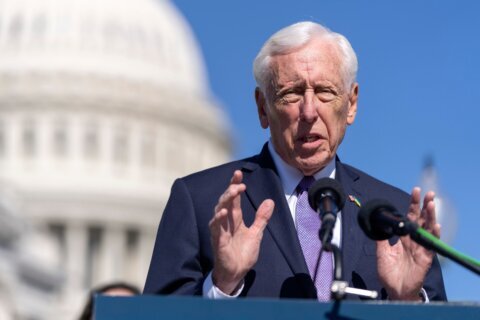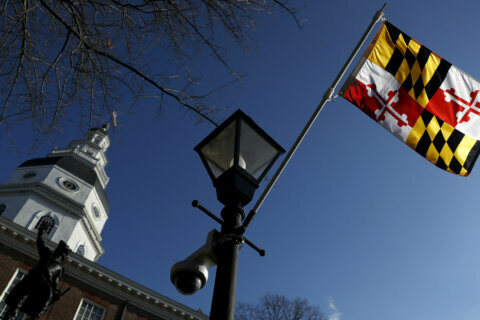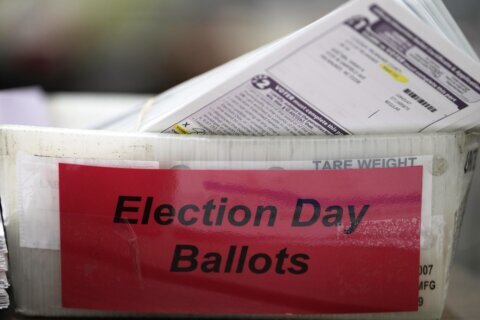The two candidates for Maryland’s open U.S. Senate seat met for their first and only debate Thursday afternoon. Now, there is a new controversy in the race.
WTOP has been reporting for weeks that Democrat Angela Alsobrooks was in a dispute over $47,000 in back property taxes for homes she owned in Maryland and D.C.
But the spotlight is now on the finances of Republican Larry Hogan.
Time Magazine is reporting that while Hogan was Maryland’s governor, he voted five times as a member of the State Board of Public Works to give state loans or grants to developers who were clients of his Annapolis real estate brokerage firm.
A spokesman for Hogan said he did nothing wrong and signed a trust agreement when he first went into office to put his brother in charge of the company, but the arrangement was not a blind trust and allowed him to keep up to date on the firm’s businesses.
Eric Cortellessa, a staff writer at Time Magazine, joined WTOP’s Shawn Anderson and Anne Kramer to discuss the latest developments.
Listen to the conversation here. The transcript below has been lightly edited for clarity.
Anne Kramer: Eric, thanks so much for joining us this afternoon. There’s a lot of legwork you put into this article, a lot of moving parts involving state loans and grants. How did this come to your attention there at Time?
Eric Cortellessa: I had been reporting on similar issues pertaining to Gov. Hogan since 2019 in my previous job as an investigative reporter for a magazine called the Washington Monthly. I wrote about how Larry Hogan, when he took office, canceled the Baltimore Red Line — a $2.9 billion mass transit project in Baltimore — and diverted that money to road highways and bridge projects, many of which were adjacent to properties he owned. That spurred several ethics complaints filed against him, and the Maryland General Assembly unanimously passing tighter new ethics law to enhance disclosure requirements for public officials.
This particular line of reporting came in the wake of that. Basically, I had been aware of his company’s client list and noticed curiously that they took it off shortly after that story was published and generated a lot of news coverage. From there, I basically just did the legwork of piecing together how many of those listed clients of the Hogan companies, which Hogan did not divest from, had received competitive affordable housing grants approved by Gov. Hogan, and how many got additional loans and grants that Hogan himself voted on at the Board of Public Works.
Shawn Anderson: Did you hear from Larry Hogan himself, or anybody representing him, about what you’ve reported? How have they responded to it?
Cortellessa: Since the story was published, I did communicate it with a representative for Gov. Hogan in reporting out the story, and they largely did not answer many of my questions.
Kramer: Did Larry Hogan at all during this time then profit from any of those state loans that he approved?
Cortellessa: Well, that remains a bit of a mystery. We don’t know where Hogan’s outside income came from directly, largely because Larry Hogan has refused to disclose it. We know that Larry Hogan made $2.4 million during the first three years of his tenure, when his official governor salary ranged from $165,000-180,000. It fluctuates each year, but far more than he was making as governor.
When he released his tax returns in 2018, as he was running for reelection, trying to position himself as sort of a Trump antithesis to win over suburban moderates and Democrats, he did that to sort of draw this contrast between him and Trump. That’s how he revealed that he had that outside income. But one thing he didn’t do when he released those returns was include the attached statements that detailed the sources of that income.
Now, we also know from his latest disclosures filed to the Federal Election Commission, for his Senate run, he reported a net worth between $12.3 million and nearly $35 million. One thing I would point out that I noticed going through those disclosures is that, and hearkening back to my original story in the Washington Monthly, which as I said, focused on transportation infrastructure projects he advanced, it mainly focused on two. In particular, one was a $58 million interchange in Brandywine, Maryland, a stone’s throw away from one of his properties, and another was $23.5 million in road and crosswalk improvements, adjacent to another property he owned.
Well, in his disclosure form, he reported earning somewhere between $100,000 and $1 million on unimproved real estate in Brandywine, and somewhere between $500,000 and $1 million on unimproved real estate in Hyattsville.
Anderson: Eric, we have just gotten some response from Larry Hogan. His debate with Angela Alsobrooks was taped just a short time ago. We want to play this cut right now just to get the Hogan response.
“So I was walking into the debate. This is what they call an ‘October surprise,’ where they dredge up some old false conspiracy theory and throw it out there, and then try to make it into a campaign issue. There’s no truth to it at all. This exact same reporter dredged up a lot of this nonsense, like three or four years ago, and was widely discredited. So I can’t really respond because I haven’t even hardly had a chance to read it. But it’s completely false, and it’s typical politics as usual.” — Former Maryland Gov. Larry Hogan
Anderson: Larry Hogan took a shot at you. First, your response to that, and how much of a political problem could this be for Larry Hogan as we head toward the election?
Cortellessa: Well, I think it sounds similar to some of the tactics we see from Donald Trump when reports come out that he doesn’t like. The first story was certainly not discredited. It triggered new ethics legislation that, I should say, was passed unanimously in the Maryland General Assembly, meaning Republicans and Democrats voted for it alike.
He’s not able to cite a single fact in any of these stories that is untrue, because the facts are true, and I think that the response signals that it is a political vulnerability for him, going into these final weeks of the election, because Larry Hogan has tried to present himself as a kind of beacon of integrity and high office, and this obviously punctures that perception.
Get breaking news and daily headlines delivered to your email inbox by signing up here.
© 2024 WTOP. All Rights Reserved. This website is not intended for users located within the European Economic Area.







